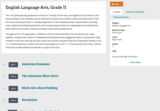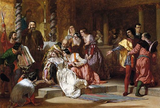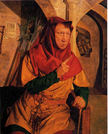
Hamilton's art installations often combine soundtracks with cloth, filmed footage, organic materials, and objects. She is also interested in verbal and written language and works with photographs and performance.

Hamilton's art installations often combine soundtracks with cloth, filmed footage, organic materials, and objects. She is also interested in verbal and written language and works with photographs and performance.

Take a special trip to the Atlanta Symphony Orchestra with GPB Education! This interactive virtual exploration offers students a behind-the-scenes experience as they learn about the science of sound and the preparation it takes to put on a live musical performance. During the program, students will also hear from various ASO musicians and watch pieces performed by the Atlanta Symphony.

Along with information about Directors, this site evaluates the Nature of Work, Working Conditions, Employment, Training, Other Qualifications, Job Outlook, Earnings, Related Occupations, and Additional Information for Actors and Producers.

Many sound engineers creatively use technology to produce audio for music, radio, film, and television. To prepare for this career path, studying media arts and science would be beneficial. [5:38]

Students design and build model landfills using materials similar to those used by engineers for full-scale landfills. Their completed small-size landfills are "rained" on and subjected to other erosion processes. The goal is to create landfills that hold the most garbage, minimize the cost to build and keep trash and contaminated water inside the landfill to prevent it from causing environmental damage. Teams create designs within given budgets, test the landfills' performance, and graph and compare designs for capacity, cost and performance.

The 11th grade learning experience consists of 7 mostly month-long units aligned to the Common Core State Standards, with available course material for teachers and students easily accessible online. Over the course of the year there is a steady progression in text complexity levels, sophistication of writing tasks, speaking and listening activities, and increased opportunities for independent and collaborative work. Rubrics and student models accompany many writing assignments.Throughout the 11th grade year, in addition to the Common Read texts that the whole class reads together, students each select an Independent Reading book and engage with peers in group Book Talks. Students move from learning the class rituals and routines and genre features of argument writing in Unit 11.1 to learning about narrative and informational genres in Unit 11.2: The American Short Story. Teacher resources provide additional materials to support each unit.

In this unit, students will take a look at the historical vision of the American Dream as put together by our Founding Fathers. They will be asked: How, if at all, has this dream changed? Is this dream your dream? First students will participate in an American Dream Convention, acting as a particular historical figure arguing for his or her vision of the American Dream, and then they will write an argument laying out and defending their personal view of what the American Dream should be.
ACCOMPLISHMENTS
Students read and annotate closely one of the documents that they feel expresses the American Dream.
Students participate in an American Dream Convention, acting as a particular historical figure arguing his or her vision of the American Dream.
Students write a paper, taking into consideration the different points of view in the documents read, answering the question “What is the American Dream now?”
Students write their own argument describing and defending their vision of what the American Dream should be.
GUIDING QUESTIONS
These questions are a guide to stimulate thinking, discussion, and writing on the themes and ideas in the unit. For complete and thoughtful answers and for meaningful discussions, students must use evidence based on careful reading of the texts.
What has been the historical vision of the American Dream?
What should the American Dream be? (What should we as individuals and as a nation aspire to?)
How would women, former slaves, and other disenfranchised groups living during the time these documents were written respond to them?
BENCHMARK ASSESSMENT: Cold Read
During this unit, on a day of your choosing, we recommend you administer a Cold Read to assess students’ reading comprehension. For this assessment, students read a text they have never seen before and then respond to multiple-choice and constructed-response questions. The assessment is not included in this course materials.

In this lesson, students will complete their presentation with their group.

This unit uses William Shakespeare’s Much Ado About Nothing as a vehicle to help students consider how a person is powerless in the face of rumor and how reputations can alter lives, both for good and for ill. They will consider comedy and what makes us laugh. They will see how the standards of beauty and societal views toward women have changed since the Elizabethan Age and reflect on reasons for those changes. As students consider the play, they will write on the passages that inspire and plague them and on topics relating to one of the themes in the play. Finally, they will bring Shakespeare’s words to life in individual performances and in group scene presentations.
ACCOMPLISHMENTS
Students read Shakespeare’s Much Ado About Nothing .
Students read two Shakespearean sonnets and excerpts from an Elizabethan morality handbook dealing with types of women, and they respond to them from several different perspectives.
For each work of literature, students do some writing. They learn to write a sonnet; create a Prompt Book; complete a Dialectical Journal; and write an analytical essay about a topic relating to a theme in the play.
Students see Shakespeare’s play as it was intended to be seen: in a performance. They memorize 15 or more lines from the play and perform them for the class. Students take part in a short scene as either a director or an actor.
GUIDING QUESTIONS
These questions are a guide to stimulate thinking, discussion, and writing on the themes and ideas in the unit. For complete and thoughtful answers and for meaningful discussions, students must use evidence based on careful reading of the texts.
What are society’s expectations with regard to gender roles?
Does humor transcend time? Do we share the same sense of humor as our ancestors?
How do we judge people?
How important is reputation?
BENCHMARK ASSESSMENT (Cold Read)
During this unit, on a day of your choosing, we recommend you administer a Cold Read to assess students’ reading comprehension. For this assessment, students read a text they have never seen before and then respond to multiple-choice and constructed-response questions. The assessment is not included in this course materials.
CLASSROOM FILMS
The Branagh version of Much Ado About Nothing is available on DVD through Netflix and for streaming through Amazon. Other versions are also available on both sites.

In this lesson, students will revise the final couplet of their sonnet, learn more about the characters in Much Ado About Nothing, and begin their Dialectical Journal. Finally, they will use their developing understanding of iambic pentameter to analyze Shakespeare’s language choices.

In this lesson, students will finish Much Ado About Nothing and see whether their predictions for how things end are correct. They will also complete their Character Chart and weigh in on what they think the topic and the theme of the play are.

In this lesson, the performances continue. The fourth group of students will perform their memorized passages from Much Ado About Nothing .

In this lesson, Shakespeare comes to life! The first group of students will perform their memorized passages from Much Ado About Nothing .

In this lesson, the performances continue. The second group of students will perform their memorized passages from Much Ado About Nothing .

In this lesson, the performances continue. The third group of students will perform their memorized passages from Much Ado About Nothing .

In this lesson, students will look at five passages from a morality handbook called The Good and the Badde . This book was written during the Elizabethan Era, and it tells us a lot about what people considered proper and improper behavior in English society. The sections they read will help them appreciate both Shakespeare’s sonnets andMuch Ado About Nothing .

People often say that mankind should learn from history. Charles Dickens, whose books are considered classics, set his novel A Tale of Two Cities in the past. He wanted his readers to learn from the bloody French Revolution and from the widespread brutality in London. Both cities (Paris and London) offer the reader a glimpse into dark and dangerous times. As students read about Dickens's Victorian setting and learn his view of the French Revolution, they will think about what makes a just world. Students will have a chance to think about their own experiences, and, using techniques they have learned from Charles Dickens, they will do some writing that sends a message about your own world.
ACCOMPLISHMENTS
To complete the unit accomplishments, students will:
Read the Charles Dickens novel A Tale of Two Cities.
Read several short pieces, including a biography of Dickens and excerpts from other literature, to help them understand Dickens’s world and the world of the novel.
Explore new vocabulary to build their ability to write and speak using academic language.
Practice close reading and participate in several role plays and dramatic readings to help them experience the dramatic writing style of Charles Dickens.
Write a vignette and a short narrative piece, and practice using descriptive detail and precise language.
Write a reflection about the meaning of Dickens’s novel.
GUIDING QUESTIONS
These questions are a guide to stimulate thinking, discussion, and writing on the themes and ideas in the unit. For complete and thoughtful answers and for meaningful discussions, students must use evidence based on careful reading of the texts.
How does good storytelling affect the reader, and how can a good story promote change in the world?
What was the Victorian view of gender roles?
How can power be abused?
What is loyalty ? What are the limits of loyalty?

In this lesson, you will talk about the ways in which images send social and political messages to the reader.In this lesson, students will talk about the ways in which images send social and political messages to the reader.

Build a greater understanding of poetry and poet's voice. Develop and interpret a poem for a oral performance. Links include presentation rubrics and participation rubric.

Listen to a traditional Cherokee story in which humans are killing too many of their animal relatives, threatening the delicate balance of nature. The lesson is that people should take "only what you need with respect and gratitude." A lesson plan is included. [5:54]